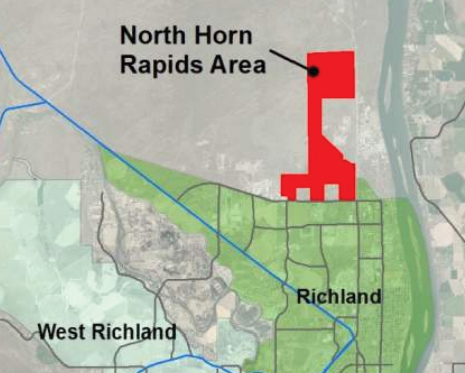
Home » Former Hanford land will give developers the massive lots they crave
Former Hanford land will give developers the massive lots they crave

April 15, 2020
Industrial developers will get a shot at buying sites 200 acres and larger in north Richland as soon as next year.

It’s been five years since the U.S. Department of Energy transferred 1,600-plus acres from the Hanford reservation to Tri-City control for eventual development. It’s been four years since most of it came under the control of the city of Richland and Port of Benton, which are tasked with attracting non-Hanford employers to set up shop.
After years of planning, the site now known as the North Horn Rapids Area could be formally marketed for manufacturing, energy and other uses starting in 2021, said Diahann Howard, the port’s executive director.
North Horn Rapids has a big role to play in the Mid-Columbia’s economic future.
The city and port envision a business park populated by private businesses that will further the cause of an economic base that’s less reliant on federal spending on the Hanford cleanup.
When it opens, North Horn Rapids will be unique in the Pacific Northwest.
Developable industrial land is in short supply. There are no industrial lots available in the 200-acre and up range in Washington or Oregon, according to a search of LoopNet, an online commercial real estate listing service.
The outsized lots inspire dreams of manufacturing, food processing, energy, science and tech businesses, all adding good-paying jobs in the Tri-Cities.
“As we move forward, the North Horn Rapids area is our future to support regional economic development efforts,” Howard said.
The former Hanford property is generally north of Horn Rapids Road between Kingsgate Road to the west and Stevens Drive to the east. It parallels the Columbia River, which is to the east, for a little over two miles.
The land had been in federal ownership since 1943, when it was incorporated into the Hanford site in support of the Manhattan project.
DOE transferred 1,641 acres to the Tri-City Development Council (TRIDEC) in late 2015. The following year, TRIDEC transferred 760 acres to the port and 581 to the city.
An additional 300 acres were reserved for Energy Northwest for a solar installation, which remains undeveloped.
The city and port own side-by-side slices of the site, but are collaborating on planning for infrastructure, roads and other pre-development concerns.
J-U-B Engineers, a Tri-City consultant, completed a master plan in April 2017, paid for with a $50,000 planning grant from the Washington Department of Commerce’s Community Economic Revitalization Board and $25,000 each from the city and port.
The master plan lays out future roads and utilities to maximize lot sizes and analyzes the capacity of local water, sewer, gas and transportation system to handle increased demand. Building roads and extending city water and sewer service will cost roughly $44 million in 2020 dollars, adjusted for inflation.
Funding sources could include grants, proceeds from land sales, tax increment financing, forming a local improvement district and public-private developer agreements.
The master plan provides a blueprint for future development, as well as guidance on the zoning that will support the job-heavy industries the port and city crave.
The 43-page document is posted at bit.ly/bentonmasterplan.
The master plan was a key step toward marketing the site to target industry, but there’s one step left.
Howard said restrictions on the deed demanded a closer look at how stormwater will be managed on a portion of the land. Aspect Consulting, a Northwest firm focused on water, is conducting the review.
When its work is complete, North Horn Rapids will be ready for marketing, although the port has informally marketed the property since the master plan was completed.
The sales pitch will be directed at businesses needing 200 to 500 acres for clean manufacturing, agriculture and food processing, energy and bioscience, among others.
“This property is important for a variety of reasons, the most important of which is to create jobs, most likely a lot of living- wage jobs,” said Amanda Wallner, marketing specialist in Richland’s economic development office.
The North Horn Rapids master plan anticipates it will take two to three decades to fully develop the oddly shaped site with irregular boundaries.
Its footprint resembles a dinosaur shape—a blocky head, thin neck, triangular body and three legs.
It straddles the Richland urban growth boundary. The area inside the city’s boundary is zoned for light industrial use while the area in the county is generally zoned to support Hanford activities.
Hanford
KEYWORDS april 2020





